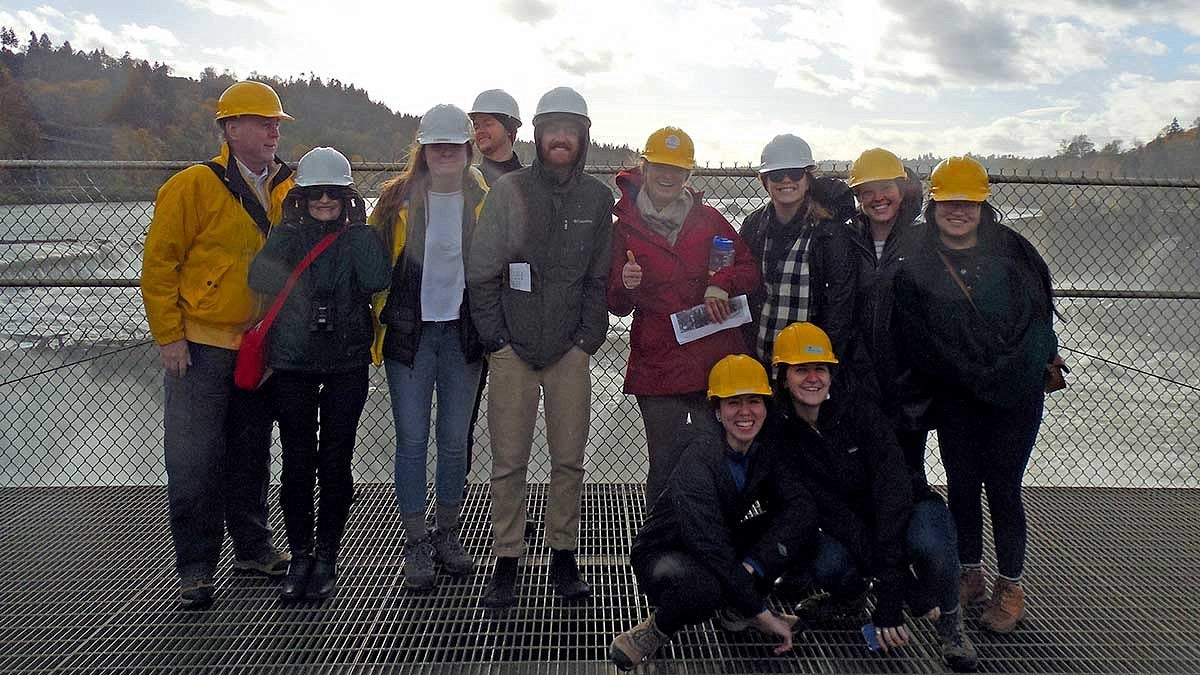
Ric Stephens’s Green Cities class is so popular there’s a waiting list to take it. Offered twice per year in the College of Design’s School of Planning, Public Policy and Management (PPPM), PPPM 445 examines the interface between urban growth and environmental concerns, but it’s Stephens’s dynamic project-based learning approach that has students willing to wait in line. Students have an opportunity to gain hands-on experience that not only leaves a memorable impact but often opens doors to their future employment.
Through a class partnership with Portland Metro, the International Society of City and Regional Planners (ISOCARP), and Young Planning Professionals (YPP), the students were tasked with studying the McLoughlin Corridor, a north-south corridor running through Clackamas County, the city of Milwaukee, and Oregon City near Portland. Seventy students and 25 international planners visited the sites, met with residents and experts, and then crafted a comprehensive set of recommendations to present to members of local government.
Lorraine Gonzales, a Clackamas County senior planner and ISOCARP US delegate, served as a local organizer, coordinating the jurisdictions and guiding a team of young planning professionals. Coinciding with the ISOCARP conference, YPP members and UO students spent a day touring each site, networking, and sharing ideas. The UO students, who were required to prepare a video on a specific research topic with recommendations for the local government, were given free rein to decide what their project along the corridor would be.
In the six years that Stephens, an instructor in PPPM, has been teaching the course, it continues to provide a win-win for all participants. Students garner firsthand field knowledge, and many of the project cities incorporate the students’ ideas into their planning projects.
“Our first [Green Cities Project] was Donald in Marion County, near Salem, a really small town in Oregon,” Stephens said. “After our report was delivered, the city adopted about a dozen of the ideas.”
Gonzales views the student input as invaluable. “The McLoughlin area has been studied since the 1990s, so the whole purpose of having the YPP and the UO students is to get a fresh look that’s not biased,” she says.
Likewise, the experience presents opportunities for students to make community and career connections.
“I get about two or three students a month who tell me that they got jobs based on their work with Green Cities,” Stephens says.
Although it’s too soon to know exactly how the McLoughlin Corridor information will be used, the advisors working on the project will take all the student reports and recommendations into account as they decide what to incorporate in the next few years.

In addition to the field work, the course also includes both real and mock hearings in a charrette-style meeting, in which all the project stakeholders attempt to resolve conflicts and map out solutions. During a public hearing simulation at the Lane County building students role-play as planning commissioners and citizens to become comfortable with the public hearing process. “We could do it in the classroom, but when they’re actually standing behind the podium, the dais, it’s a very different feeling,” Stephens said. “There are TV cameras on them and an audience behind them. That’s something they wouldn’t have gotten otherwise.”
Amber Shackelford, an undergraduate working to go into urban planning, says the public hearing simulation was her favorite part, and she would definitely recommend the class to other students. “It was really fun and definitely useful,” she said. “I’m sure I’ll have to attend more hearings given my career objectives.”
For Nikhil Rajbhandary, who is pursuing a career in public policy or planning, the most memorable part of the McLoughlin field trip was the opportunity to attend the ISOCARP/OAPA conference in Portland, which featured a theme on Smart Cities.
“It was an interesting experience to see how professionals around the world were planning cities based on changes in technology,” he said. “It also was extremely uplifting to see individuals and countries dedicated to sustainable development and studying the effects of climate change on urban development.”
While project-based learning requires strategic planning and hard work, Stephens believes that students benefit greatly from being exposed to and engaging with the community. “I don’t think any student will ever forget conducting a charrette in another city with local citizens and having them get excited about it. It’s probably going to stick with them. I want them to have skills where they’re going to be confident and be good citizens as well.”
Visit the McLoughlin Corridor project to learn more and to view student videos, for example, check out Sustainable Transport by Lucy Kelly and Effective Use of Public Art by Camille Clingman-White.
Story by Sharleen Nelson
